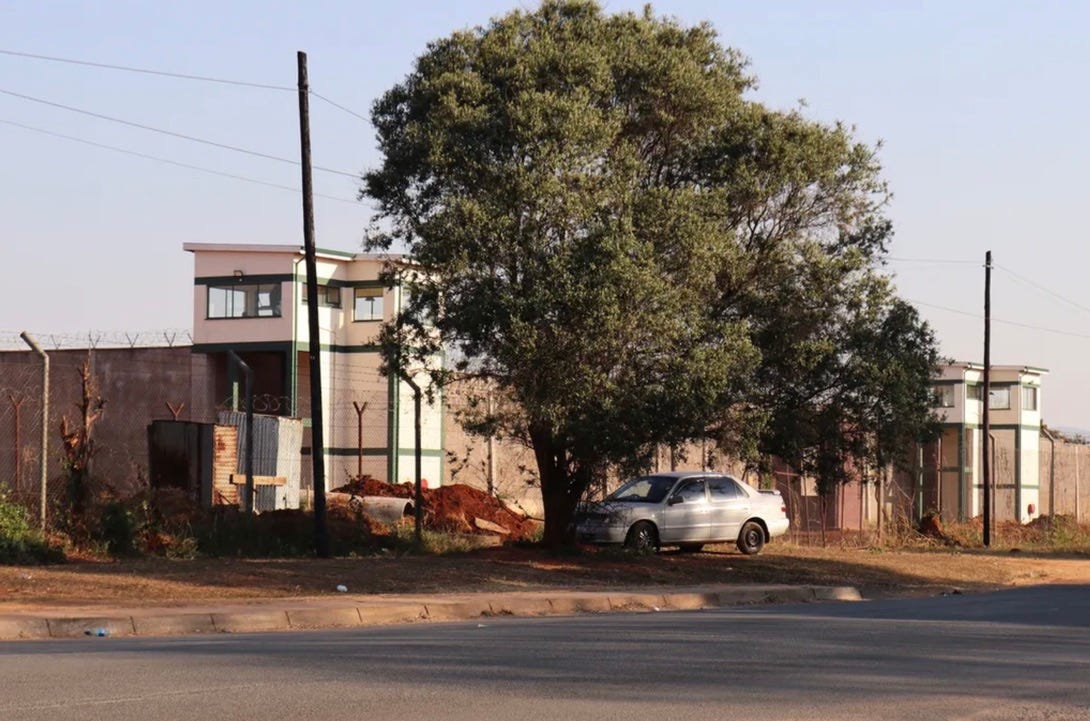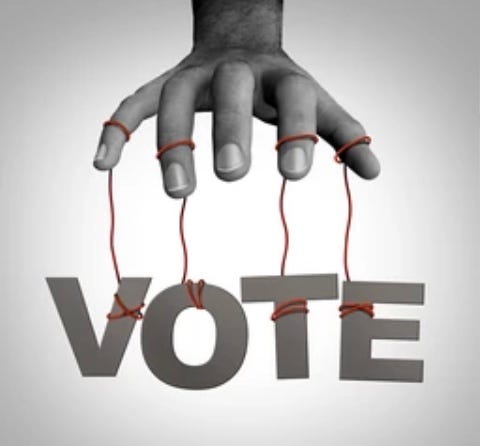At the 180-Day mark, Project 2025 keeps unfolding with a new cash infusion of the Big Beautiful Bill and terrible SCOTUS decisions, despite widespread public disapproval of Trump’s shredding policies.
While the media and public gossip are distracted by the resurfacing Epstein scandal tearing MAGA apart, Project 2025’s architects with the Trump team stay the course to advance their autocracy agenda.
Santa Barbara, California, protesters denounced Trump’s “Big Ugly Bill” at the July 17th nationwide day of action.
Photo: Amy Katz | Zuma Press Wire | Shutterstock
Don’t be overly distracted by Epstein: Project 2025 keeps advancing
This past weekend, we reached the six-month mark of Trump’s rollout of Project 2025, which mirrors its 180-Day Playbook to dismantle “the administrative state.” At the three-month mark, I reported that 80% of Project 2025’s main policy proposals were being implemented across the 30 departments of the federal government. As of Saturday, the remaining pieces are actively being pursued, but the administration hasn’t quite completed its entire agenda. But they have scored big victories provided by a complicit GOP-dominated Congress and by a conservative majority on the Supreme Court that was put into power by Project 2025’s big dark money funder, Leonard Leo. These decision include SCOTUS backing Trump’s move to dismantle the Department of Education, and backing Trump’s deportation of asylum seekers to third-party countries and not their homes, a breach of prior law.
At the same time, the architect of Project 2025’s administrative coup, Office of Management and Budget head Russell Vought, made a stealth move in late March to hide from public view the funds that were being allotted to each federal agency. That has made it much harder to track which programs are being cut and to what extent, which are stalled, and where the hiring vs. firing picture stands within agencies. That’s one reason I’m still measuring the 180-day rollout.
But all along, as we noted at the 90-day mark, myriad legal challenges by progressive legal groups, allied with civil society actors and federal unions representing millions of federal workers, have reversed some of the early wins.
A big win for transparency
Just yesterday, for example, Public Citizen scored a big win by reversing – after weeks of effort – Vought’s removal of the OMB Public Apportionments Database from its website. Public Citizen filed its lawsuit on April 8th, representing Citizens for Responsibility and Ethics in Washington (CREW). In this critical decision, a district judge ruled that the Trump administration is “required to stop violating the law,” since the OMB is required by law to publicly post information about the funds allocated to each federal agency. “There is nothing unconstitutional about Congress requiring the executive branch to inform the public of how it is apportioning the public’s money,” wrote the judge.
“Americans have a right to know how taxpayer money is being spent,” stated Nikhel Sus, Deputy Chief Counsel at CREW, in a post-victory statement. “Ensuring public access to this information serves as a critical check on the executive branch’s abuse and misuse of federal funds.”
By now, we know to expect an appeal of the ruling by Vought at the OMB or anyone else in the Trump administration, since they aren’t easily accepting judicial decisions when they lose, and are challenging federal judge rulings in particular. But this legal victory will make it possible again for us to better track the funding that is being withheld as a key strategy of Vought’s effort to cripple and dismantle the federal government. Following the money allows us to better evaluate what remains of the 180-day Playbook agenda. For those who want to view the weekly progress on by-department items, the Project 2025 tracker provides capsule updates in each department.
A Savannah protester at the Big Beautiful Backlash Rally and March on Saturday, July 19, 2025 at Thomas Square Park in Savannah.
Photo: Richard Burkhart | Savannah Morning News
The rocket-fire boost provided to Project 2025 by the Big Beautiful Bill
As we discussed in prior posts, Trump’s success in controlling a pliant GOP led to Congressional passage of the historic “Big, Beautiful, Bill,” despite intensive Democratic opposition. The federal appropriations budget is designed to provide tax breaks and advantages for the wealthiest by gutting the federal safety net for the poor and middle-class Americans. The BBB has provided a major boost in the form of funding to now allow the administration to move quickly to advance key Project 2025 objectives already underway, and pursue the remaining ones.
Expanding a surveillance state
This includes Trump’s goal of using immigration as an issue to purge America of brown and Black asylum seekers and other immigrants, and as a stepping-stone to establish a massive domestic law enforcement agency. While Trump is far from close to his vaunted goal of arresting arrest and deporting one million undocumented immigrants in a year – his campaign promise to his MAGA base – the BBB provides a massive infusion of money to hire many more immigration agents, build more detention facilities, and, in doing so, expand and consolidate Project 2025’s vision of a massive domestic law enforcement and surveillance agency – an uber-Department of Homeland Security, one that even incorporates federalized troops. But every enforcement step has also invited more public opposition, fueling a counter-resistance that also grows more muscular.
LA residents faced off with National Guards pulled to help ICE arrest immigrants to deport. June 2025.
Photo: Eugene Garcia | AP video
Even before the BBB funds flowed, Trump instructed ICE agents to flood Los Angeles for days of raids in June, backed by some 4,000 guard troops who were temporarily stationed to help ICE, who were directed to brutally seek out and arrest individuals in neighborhoods across the city. LA showed how intensely local Americans have stepped up to push back, engaging in non-violent protest and a few violent clashes after ICE and local police, the latter also pulled in to support the deportation effort, shot rubber bullets and lobbied tear gas at neighbors rallying to protect each other from forced removals by masked, heavily armed agents. Overall, the LA resistance was remarkable as a show of local unity and nonviolent, but firm, loud resistance to ICE’s violent assaults on people they moved to arrest. While Trump immediately branded LA as a city out of control, the media images showed law enforcement agents were the ones seeding and stoking violence toward anyone moving to challenge their actions.
The images from LA have revealed how desperate – and determined -- the Trump administration has become to meet a quota of 3,000 arrests a day set by Trump’s cruel immigration plan architect, Stephen Miller. LA is thus our new litmus test of resistance. While ICE agents managed to arrest many more people, the images of armed agents on horseback and on foot moving across city parks underscored how Trump has embraced fear tactics to intimidate the public – and how it hasn’t worked. These intimidation actions drew global outrage.
Across LA, the spirit of resistance and defiance to autocracy remains very high, while morale among thousands of National Guard troops has sharply fallen. A small number of troops refused to participate in the ICE raids, while others are quitting or considering leaving, viewing the forcible deportation mission as counter to their understanding of civic duty and protecting national security. Media reports have captured the post-deployment rejection of Trump’s policies by national guard troops. Among them, the New York Times reported how soldiers expressed their discontent during the raids, some defecating inside Humvees and showers at their Southern California base, requiring officials there to tighten bathroom security there. These actions spoke powerfully, saying in a word: we think this is shit.
The deportation drive is also costing American taxpayers far more than Trump planned. ICE’s agency budget was already running $1 billion over budget, per Axios in mid-June.
Americans loudly decried Trump’s intimidation tactics, including deployment of armed soldiers on horseback across McArthur Park in early July.
Photo: ABC News
Accelerating Remigration
Trump’s immigration officials have still doubled down to accelerate arrests and ICE detentions. The new BBB funds are already paying for the hiring of private security and correctional contractors from Canada and the US to set up and manage the inhuman concentration camp, “Alligator Alcatraz,” in the Everglades, designed to house 5000 detainees. Officials in some other red states are mulling building similar camps and cashing in on the detention bonanza. The goal is to arrest and return asylum seekers to either home or third-party countries, bypassing their right to due process – what is known as remigration. This includes green card holders and those with citizenship appointments who’ve followed all the legal steps demanded by US officials. Trump officials got a boost from the Supreme Court to do that, too; on June 23rd, the conservative SCOTUS majority backed a blatantly illegal step of deporting migrants to countries that are not their homes.
We’ve been reading about these escalating ICE arrests on a daily basis, as well as cases of citizens picked up accidentally by ICE agents who’ve been thrown for weeks to months inside ICE jails, too. Alligator Alcatraz is going to cost $450 million dollars to operate for a single year – but there are other hidden costs, including non-transparent fees paid to contractors like Geo Group or Core Civic, or GardaWorld, a Canadian security company with a controversial history that has ties to a Ron DeSantis donor. GardaWorld’s role at Alligator Alcatraz remains fuzzy, but they’re one of a half-dozen private companies quickly reaping the benefits of the BBB. You can read more about GardaWorld’s checkered history here.
Venezuelans released from CECOT embrace upon arrival at Simon Bolivar International Airport, in Caracas, Venezuela, July 18, 2025.
Photo: Jesus Vargas | Getty Images
CECOT prisoners released in prisoner swap
There was a great celebration of tempered joy this past weekend over news that Trump had negotiated a hostage deal with two autocrats — Nayib Bukele of El Salvador and Nicolás Maduro of Venezuela — that allowed for the release to Venezuela of over 200 US deportees who’ve been imprisoned for months in torture-like conditions in the anti-terrorist mega-prison known as of CECOT, in El Salvador. They were exchanged for ten Americans jailed in Venezuela, in a deal whose details are still trickling out, but lack transparency. The ten US citizens were not all named, and a State Department official told NPR they included U.S. citizens and permanent residents who were "wrongfully detained" in Venezuela less than a year ago. At least 130 of the 230 men sent by Trump officials to CECOT four months ago were removed without due process under the Alien Enemies Act of 1798. On Friday, Venezuelan officials said they’d secured the release of 252 Venezuelans from CECOT.
The stories of abuse they experienced inside CECOT have quickly streamed out: “ We spent four months without any contact with the outside world,” released detainee Arturo Suárez told Venezuelan broadcaster teleSur, who stated firmly, “We were kidnapped.” Suárez testified that, “We got a beating for breakfast. We got a beating for lunch. We got a beating for dinner.” While everyone is rightly cheering their release, many media stories have noted that the deal makes Maduro, a hardline leftist dictator, look like a humanitarian, and gives Bukele good press too, while taking the pressure off of Trump officials who’ve been accused of violating US and international human rights laws by implementing their policy of forcible remigration. Venezuelan and Salvandoran citizens have vocally protested the jailings of Venezuelan asylum seekers to the US in Bukele’s terror facility.
Already, Venezuelan officials said they plan to investigate reports of abuse of the detainees held in CECOT. They have gathered 123 complaints of abuse, including reports of sexual assault, torture and beatings by Salvadoran prison guards.
The guard’s tower at the Eswatini prison where five Trump deportees are house in isolated units.
Photo: Associated Press
Who’s still disappeared?
It’s also important to note other news stories in the past two weeks that have documented how ICE has green card holders and individuals showing up for their citizenship ceremonies, while it continues to broker deals with African and countries to take deportees it forcibly removes. Remigration to a third-party allows the administration to avoid the pesky problem of horrible conditions in home countries that make it impossible to safely return asylum seekers to countries. Instead, they’re disappeared into countries without any legal recourse and far from the eye of the US public or their relatives in home countries.
The Trump administration just sent five deportees – all reportedly with serious criminal records – to be detained in isolation units of a prison in the tiny African country of Eswatini. This week, citizens there staged a public protest. They’d had no prior knowledge of the plan, and oppose it. "Our country must not become a place for foreign governments to dump their prisoners," stated Lucky Lukhele, spokesperson for the Swazi Solidarity Network (SSN), a pro-democracy group, who spoke with CNN. “Trump is racist, considering poor and developing countries as places where he dumped his added ‘trash,’” added Lukhele.
As with other aspects of the Trump plan, critics are saying we need to follow the money. How much money does Eswatini get for taking care of Trump’s problem? What about Venezuela’s dictator Maduro? Trump is waving cash-for-prison services at foreign leaders, promising trade and other deals. That’s a big motive for cash-strapped countries who facing Trump’s stiff foreign tariffs.
US citizen George Retes was brutally arrested by ICE agents during a farm raid
Photo: United Farm Workers
What’s happened to the deportees once home?
As it stands now, we still lack solid figures on the numbers of people in ICE detention in and outside the US. We also don’t know what’s happened to those who are released after leaving the foreign detention centers that serve as stopping points for deportees. The majority of asylum seekers left countries in political or economic crisis; many fled gang and other violence. They’re now returning to the homes they fled. Who’s going to track how they are faring? In a country where speaking out gets you put in jail? We need to raise the noise about the conditions facing the CECOT returnees, as well push for investigations of their experiences in detention, once the weekend cycle of news is gone. We need to raise the demands made by their relatives still in the US.
Who else is still locked up in CECOT? We know we can’t believe either the Trump or Bukele administrations to tell us the full truth, since they haven’t in the past. We shouldn’t overly believe the repressive Maduro regime. In Venezuela, Madura treats critics by locking them up, and has been accused of gross human rights violations by established rights groups, forcing an entire generation of Venezuelans to flee their homes, unable to make a living, access basic resources, including health care, and unable to enjoy basic freedoms under the Madura autocracy.
Maybe Maduro will play nice, with the eyes of the world on him now. Maybe he’ll arrest, deport, beat and imprison. The same with Bukele. Salvadoran rights groups continue to track his repressive regime.
We also need to raise our voices to protest inhumane conditions for the Eswatini asylees, and others who may be deported in the days to come. We know what recently happened to George Retes, 25, a US citizen and a security guard worker at Glass House Farms in Camarillo, CA, who got caught up in a July 10 raid on migrant farmworkers as he was arriving to work. Despite Retes telling ICE agents he was a citizen, they broke the window to his car, dragged him out, and arrested him.
The raids were caught by media, so we know about that incident. But what about the workers arrested that day? Their names and stories? Where are they? What about others that are taking place without media or witnesses? What we know from detainees is that they enter ICE facilities and have little recourse to leave or access lawyers to help them. Many view their treatment as the CECOT deportees did – as cases of kidnapping and forced detention. Immigration activists are doing their best to track transfers, but ICE is deliberately hiding its movements from public scrutiny.
The bottom line is that, at the 180-day mark, Trump’s massive illegal deportation plan is expanding, not shrinking, and is increasingly marked by violence, and targeting of individuals with green cards, and is impacting citizens, too. Few residents in LA are the same after the ICE raids these past weeks. No one is in denial about the lengths to which Trump et. al. are willing to go to use armed force to enforce their illegal policies. There are many missing people inside ICE’s prisons. We need to make more noise about all of this.
Photo: Shutterstock
Another autocratic goal: controlling the vote
I also want to highlight the importance of tracking and protesting the growing attacks on citizenship that denaturalization represents, and pay attention to the other attacks on citizenship that Trump officials have advanced recently. We saw the Executive Order, backed by an awful SCOTUS ruling, to allow a reversal of birthright citizenship, a Project 2025 goal that will continue to be legally challenged by progressive groups. Last month, we heard that the Trump administration, via DOGE, is building a massive, searchable database system, purportedly to allow states and cities to ensure that only citizens are voting.
As democracy advocates point out, this new database will provide a dangerous tool to find and target undocumented immigrants, and gain access to all sorts of personal information. It is also a stepping-stone to gain and consolidate information about every American, creating a national roster of citizenship that poses a threat to our Constitutional rights to privacy. One privacy expert, University of Virginia School of Law professor Danielle Citron, told National Public Radio, which first reported the story, that the data aggregation project represents a "hair on fire" development for the United States.
That’s not all, of course. Trump’s Department of Justice is also demanding that nine states turn over voter records – a demand that’s getting push back from state officials, even in red states. The DOJ sent letters to officials in Alaska, Arizona, Colorado, Florida, Minnesota, New Hampshire, New York, Oklahoma, Pennsylvania, Rhode Island, and Wisconsin. Democracy advocates warn that the administration is pressing state leaders to tighten voting rules, under the guise of a crackdown on illegal voting. In reality, the larger goal is to try to remove voters from the rolls who might support Democratic or Independent candidates, all with an eye to the mid-term elections.
Voting rights monitors are sounding the alarm.
“I think that should concern all Americans,” said David Becker, the founder and executive director of the Center for Election Innovation & Research, and a former trial attorney in the DOJ’s voting section, who spoke to Democracy Docket about the DOJ’s agenda. “Because it appears the Justice Department is trying to acquire sensitive information on all Americans for who knows what purpose, with very, very questionable statutory authority.”
Voting rights advocates and progressive state officials are actively pushing back, filing lawsuits and calling out these efforts to restrict voting rights. But as many point out, we need a proactive plan to safeguard America’s right to vote, and to loudly raise our voices to protest another step to weaponize citizenship and access our personal data. We’ve already seen the lengths to which Trump officials have challenged the vote in past elections. The gloves are off.
Liz Brumm, of Okemos, protests Medicaid cuts at a 'Good Trouble Lives On' protest in Lansing, Michigan, July 17.
Photo: Nick King | Lansing State Journal
Shredding the safety net
A quick look at the Project 2025 tracker shows other ways the BBB has given Trump officials license to act quickly to gut different agency programs including those benefiting the most marginal. You can note items marked “Enacted as part of the reconciliation bill” in the tracker to see some immediate concrete impacts. Topping the chart for the past two weeks are several items that represent the slashing of the safety net: a reduction of federal incentives for states to expand Medicaid coverage, the long-planned imposition of a work requirement for recipients of Medicaid and SNAP benefits; cuts in the Thrifty food plan at the US Department of Agriculture; restrictions of the Low Energy and Heat program.
Another temporary victory to protect Planned Parenthood
On a small, but important, positive note, legal challenges are slowing the administration’s agenda in some areas, even if they put just a temporary brake on the rapid rollout of the BBB. A federal judge just blocked part of the BBB’s bill that aimed to restrict Medicaid funding of Planned Parenthood centers that is used to fund birth control, routine exams, and STD screenings. The BBB called for ending Medicaid payments for one year to abortion providers that received more than $800,000 from Medicaid in 2023, even to those like Planned Parenthood offering other services. The judicial ruling partly is a brake, and also sends a signal. Credit Judge Indira Taiwani of the District Court of Massachusetts for holding the line on the rule of law in this case. It’s a rare victory within a broader assault on reproductive rights that is embedded into the BBB, and takes aim at reversing services and blocking access to abortion, in particular.
You can see the BBB’s negative impacts in the area of climate and environmental protections, too. Recent items include reductions in protections for marine life and the cuts in federal support for green energy and electric vehicles versus the increase of offshore oil and natural gas lease sales.
In the big picture, then, the BBB is providing rocket fuel to accelerate Project 2025’s rollout. It’s important to track what’s being cut, and confront public officials who voted for the BBB with the consequences of their actions. That’s also something to focus on as we look toward the mid-term elections and strategize.
Olivia Sawyer, right, and Olivia McDonald of Washington D.C. join a protest rally against US public education cuts at the U.S. Department of Education on March 14, 2025.
Photo: Josh Morgan | USA TODAY
Eliminating the Department of Education – and advancing a Christian education agenda
While the BBB represents a financial hammer to shape policy and destroy programs, the Supreme Court also gave Trump a judicial carte blanche to back Project 2025’s Christian nationalist agenda. On July 14th, the conservative majority of the Supreme Court justices ruled to back the Trump administration’s efforts to radically reshape the Department of Education by mass firing 1400 of its DOE employees. The SCOTUS ruling put a temporary stay on a lower US District Court ruling that viewed the DOE mass firings as illegal — a step toward a full erasure of the department that oversees federal public education. The court’s actions also follow a Trump Executive Order on March 20th calling for eliminating the Department of Education. In a blistering 19-page dissent, Justice Sonia Sotomayor blasted the ruling, calling it “indispensible.’ She was joined by Justices Elena Kagan and Ketanji Brown Jackson.
These developments mirror Project 2025’s major goal: to not only end “woke” public secular education, but replace it with Christian and Bible-based teaching. The SCOTUS ruling is a big win for Project 2025’s authors, many of whom are radical Chistian evangelists who back a long-term view of the US as a Christian state. That includes DOE Secretary Linda McMahon, who’s wasted no time pushing to transfer public education dollars and programs toward private, charter and Christian educators, often under the guise of a “parent’s rights” agenda. The anti-education agenda includes the removal of funding for programs that help students with special needs. The BBB also includes more money to favor Christian institutions, including for education.
The BBB now makes it harder for poorer students and those living with disabilities to go to college, too, while pushing trade schools and private education – all Project 2025 goals. Among the BBB’s targets: ending student loans.
Just now, the larger student loan forgiveness programs that Biden had pushed hard to expand was rolled back, while stiffer penalties will be imposed for those defaulting on loans. The DOE has now suspended student forgiveness programs under the Income-Based Repayment plan, or IBR, which is one of several income-based loan programs for student borrowers. It was the only plan not subject to legal challenge or court injunction. All this is verbatim Project 2025, too.
Houston protester at Good Trouble Lives On march, delivering the message of John Lewis’s courage
Ronaldo Schemidt— AFP |Getty Images
The Growing Chorus of Resistance: Never Be Afraid
On July 17th, we saw another round of nationwide protests in over 1500 sites across the US against the Trump administration as people joined a “Good Trouble Lives On” day of action that honored civil rights leader John Lewis. News coverage of the events often mentioned how many protesters were calling for more concrete action and tactics to counter the escalated ICE and other Trump attacks and the recent passage of the BBB by a GOP majority in Congress. Many noted that John Lewis had often engaged in acts of nonviolent civil disobedience to demand the civil rights we are losing today.
“One of the things that John Lewis would always say is that if you see something that’s wrong, you have an obligation to speak up, to say something, to do something,” Daryl Jones, co-leader of the Transformative Justice Coalition, told reporters at a Good Trouble event in Chicago. “That’s what July 17 is about – seeing things across this nation, seeing things that are being impacted, that are just not right. We’ve got to stand up and say something.”
Others are saying it’s time for progressives to get tougher. “If they have to shut down the entire legislative process until the Republicans fold, OK, shut it down,” Atlanta protester Jace Snyder told The Guardian, echoing a growing sentiment of resistance marchers. “Shut down the Senate. Don’t pass anything. Do whatever is needed to make it so that these cuts don’t happen to vital agencies.” As he put it, “We’ve gone beyond the ‘be polite to your political opponents,’ phase, because they’re not giving us the same courtesy. Fight, fight, fight with every single tool available you can.”
What’s next? Rage Against the Regime, August 2nd
As anti-Trump resistance grows even bigger, and groups begin shifting to tactics, including strategies to turn the Project 2025 agenda into a vote of no confidence for next year’s mid-term elections, organizers of the nationwide marches are urging people to keep the public pressure and visibility on high.
Next up is a nationwide day of action, Rage Against the Regime, on August 2nd, led by 50501. Many groups have already signed on to host local affiliate events. To learn more, check out the August 2nd events page and map.
Help spread the word!
As always, we invite you to amplify the information in this newsletter by restacking it, and sharing it on your social media. We are also adding resources to our Resisting Project 2025 campaign, and invite you to share information on resistance actions or other news with our team. We’ll be updating you on the remaining big ticket items of the unfolding Project 2025 agenda in the weeks ahead. Stay tuned. - ACD
















Thank you for a comprehensive update on what’s happening and planned